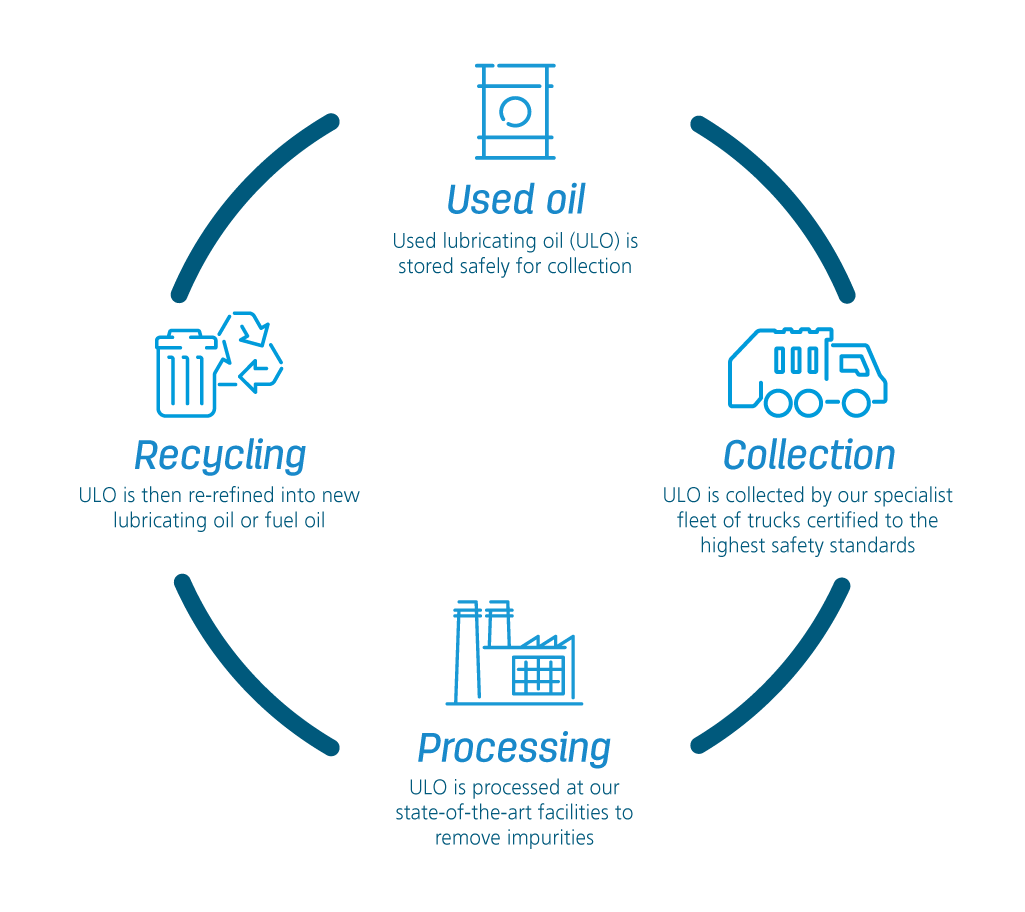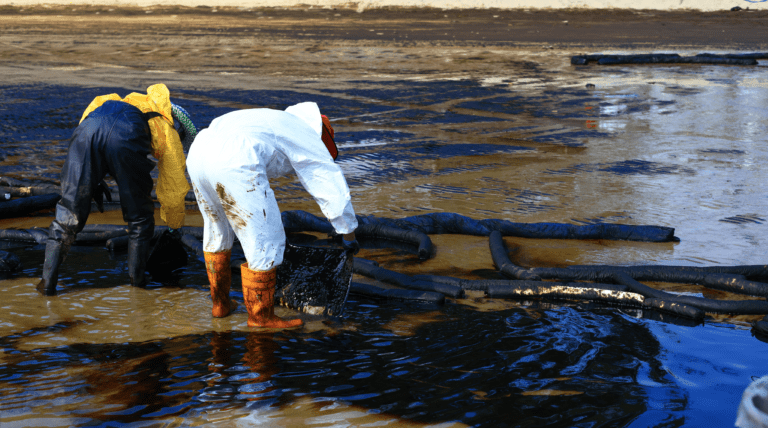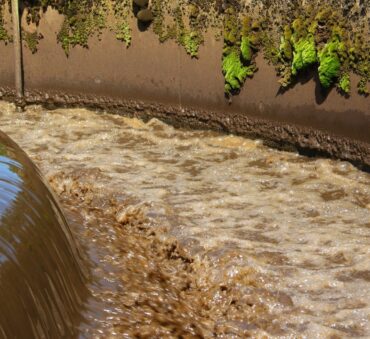The earth is grappling with the consequences of pollution, and improper waste oil disposal is a significant contributor.
To put it into perspective, one liter of oil can contaminate one million liters of fresh water, so it’s no surprise that hundreds of millions gallons of water gets polluted by oil alone each year. While this is alarming as it is, the economic implications are equally concerning, with cleanup costs reaching billions of dollars.
With this, it’s clear to see that we need to make some collective changes. But where do we start? What are the main causes? What exactly are the risks and effects of improper disposal? And, of course, how can we manage it safely and correctly?
In this article, we hope to shed some light on these important questions.
Key Takeaways
- Environmental and Economic Impact: Improper oil disposal is a significant contributor to pollution, with one gallon of waste oil contaminating 1 million gallons of fresh water. Annually, over 200 million gallons of waste oil enter the environment, leading to billions of dollars in cleanup costs.
- Understanding Waste Oil: Waste oil, or Fats, Oils, and Greases (FOG), is a byproduct of various processes and is characterized by contamination that renders it unsuitable for its original purpose. The distinction between used oil and waste oil is vital for proper management.
- Risks and Safe Disposal: Improper oil disposal poses serious environmental and health risks, including soil contamination, water pollution, air quality degradation, wildlife impact, and human health hazards. The blog provides comprehensive tips on how to safely dispose of oil, including proper storage, understanding the type of oil, using approved equipment, and consulting professionals.
- Role of Oil Disposal Companies: Professional companies like Shapiro play a crucial role in managing waste oil responsibly and efficiently. They ensure compliance with legal requirements and contribute to sustainability by recycling waste oil.
What Is Waste Oil (or FOG)?
Waste oil, often referred to as Fats, Oils, and Greases (FOG), is a byproduct of various industrial processes and is characterized by contamination with physical or chemical impurities that render it unsuitable for its original purpose. Unlike reusable oils, waste oil’s contamination diminishes its functional value and poses significant environmental and health risks. It requires specialized handling and disposal methods to mitigate these risks.
Examples of Used Oil and How it Differs to Waste Oil
To fully understand what waste oil is, we should take a look at its various forms and classifications.
Used oil is
Used oil is something we encounter in various forms. It’s the oil that has been utilized in engines, hydraulic systems, or even in cooking, but still retains some of its original properties. While it may have been contaminated with impurities like dirt or other chemicals, used oil can often be cleaned, treated, and reused. Examples include hydraulic fluid from machinery, motor oil from vehicles, and cooking oil from restaurants.
Used oil is not
Now, let’s clarify what used oil is not. It’s not any oil that has been so severely contaminated that it can no longer be used for its original purpose or even recycled. If an oil has been mixed with hazardous waste or has been altered to such an extent that it cannot be cleaned, it falls outside the category of used oil. This distinction is vital, as it affects how the oil must be handled, stored, and disposed of.
Used oil vs. waste oil
So, what’s the difference between used oil and waste oil? It’s a matter of degree and potential for reuse. Used oil, despite being contaminated, can often be cleaned and reused in some way. Waste oil, on the other hand, has reached a point where it cannot be reclaimed. It’s the end of the line for waste oil, requiring specialized disposal methods to prevent environmental harm. Understanding this distinction is essential for proper management and reflects a broader commitment to environmental stewardship and responsible consumption.

Environmental Risks of Oil Disposal
Improper oil waste disposal is more than just an environmental concern; it’s a ticking time bomb with far-reaching consequences. These include the following:
- Soil Contamination: When waste oil seeps into the ground, it can render the soil infertile and unusable. This not only affects agriculture but also disrupts entire ecosystems that rely on healthy soil.
- Water Pollution: Perhaps one of the most alarming effects is the contamination of water bodies. A small amount of waste oil can pollute large volumes of water, harming aquatic life and making the water unsafe for consumption.
- Air Quality: Improper disposal can also lead to air pollution. When waste oil is burned without proper controls, it releases toxic fumes that contribute to poor air quality.
- Wildlife Impact: Animals, both on land and in water, can suffer from exposure to waste oil. It can affect their reproductive systems, cause deformities, and even lead to death.
- Long-term Damage: The effects of improper disposal are not always immediate. Waste oil can linger in the environment, causing long-term damage that is difficult and expensive to remediate.
Human Health Risks of Oil Disposal
When we think of improper oil waste disposal, we often consider the environmental impact, but the threat to human health is equally concerning. The health risks of oil disposal include:
- Respiratory Problems: Inhalation of particulates, sulfur dioxide, and nitrogen dioxide produced by burning used oil can lead to respiratory issues, loss of lung function, and even death in extreme cases.
- Skin Conditions: Contact with used oil can cause various skin problems, including eczematous and contact dermatitis, folliculitis, and melanosis.
- Cancer Risks: The presence of PAHs, benzene, toluene, and chlorinated solvents in used oil can induce various types of cancer, including skin, bladder, and liver cancer.
- Heavy Metal Poisoning: Metals like arsenic, cadmium, and chromium found in used oil can concentrate in the environment, leading to illnesses such as anemia, skin ulcerations, cardiovascular disease, and cancer.
- Organochlorine Compounds: Combustion of fuel containing carbon and chlorine can produce harmful compounds like dioxins and furans, causing skin toxicity, immunotoxicity, carcinogenicity, and adverse effects on reproduction and endocrine functions.
- PCBs: Though found in low levels, PCBs in used transformer oils can accumulate in human tissue, causing liver damage, respiratory problems, cancer promotion, endocrine disruption, and neurotoxicity.
Tips On How to Safely Dispose of Oil
Disposing of waste oil is not as simple as pouring it down the drain. It requires careful consideration and adherence to specific guidelines.
Properly Storing Waste Oil: The journey to responsible oil disposal begins with proper storage. Use the original containers or appropriate ones that are leak-proof. Label them clearly and ensure they are tightly shut to prevent environmental damage.
Understanding What You’re Disposing Of: Know the type of oil you’re dealing with. Some oils can be safely burned, while others may require professional disposal services. Understanding the nature of the oil ensures safe and effective disposal.
Securing Waste Oil: Store waste oil in a secure location, away from children or pets, and separate it from unused oil to avoid confusion and potential mishaps.
Avoiding Drains and Septic Systems: Never pour oil down sinks or into septic tanks. This can lead to clogs and environmental harm. Proper storage and labeling are essential for later safe disposal or recycling.
Regular Maintenance: Proper maintenance of vehicles and equipment minimizes oil leakage and reduces the need for disposal, promoting overall environmental responsibility.
Burning Oil Safely: If burning is your chosen method of disposal, use a heater specifically designed for waste oil. Quality equipment ensures the safe and efficient recycling of the oil.
Using Approved Equipment: Invest in high-quality, approved waste oil disposal equipment that can handle a wide range of oils. This ensures compliance with regulations and enhances safety.
Following Guidelines: Adhere to the manufacturer’s instructions and established guidelines when disposing of waste oil. Familiarize yourself with the equipment and follow the procedures diligently.
Disposing of Contaminated Items: Don’t overlook other items that have come into contact with waste oil, such as filters. Proper disposal of these items is equally vital to preventing environmental impact.
Consult with Professionals: If in doubt, consult a professional waste oil collection and disposal company like Shapiro, who will have the right equipment and experience. They can ensure safe and effective disposal, taking into consideration factors like expertise and cost.

Disposal of Waste Oil Regulations
n the United States, waste oil disposal is subject to stringent legal oversight. These legal frameworks are designed to ensure that waste oil is handled, stored, and disposed of in a manner that safeguards both the environment and human health.
Resource Conservation and Recovery Act (RCRA): This federal law oversees the management of hazardous and non-hazardous waste, including used oil. It sets standards for the collection, storage, and disposal of waste oil.
Clean Water Act (CWA): The CWA aims to prevent water pollution, including contamination from waste oil. It requires permits for discharging waste oil into navigable waters and sets standards for oil spill prevention and response.
Toxic Substances Control Act (TSCA): This act regulates the introduction of new or already existing chemicals, including waste oil. It ensures that the chemicals do not pose unreasonable risks to health or the environment.
Comprehensive Environmental Response, Compensation, and Liability Act (CERCLA): Also known as the Superfund, this law holds parties responsible for the release of hazardous substances, including waste oil, into the environment.
Federal Underground Storage Tank (UST) Regulations: These regulations govern the storage of petroleum and hazardous substances, including waste oil, in underground storage tanks.
Oil Pollution Act (OPA): This act focuses on preventing and responding to oil spills, including those involving waste oil.
How Can Oil Disposal Companies Help?
Waste oil disposal is far from a straightforward task. As we’ve seen, its mismanagement can spiral into environmental havoc, triggering health issues, serious lawsuits, costly economic repercussions, and tangled complications with legal requirements and regulations. That’s why turning to a certified and professional company is a wise choice. At Shapiro, we understand these challenges all too well. Our liquid waste disposal services are designed to handle waste oil with the utmost care and compliance. We take the guesswork out of the process, ensuring that waste oil is managed responsibly, efficiently, and in line with all legal requirements.
But our role goes beyond mere compliance. We also contribute to sustainability by recycling waste oil when possible, turning what could be a harmful substance into something useful again. By leveraging state-of-the-art technology and collaborating with recycling facilities across the country, we ensure that waste oil is given a new lease on life.
Conclusion
The earth’s struggle with pollution is a battle we all share, and the improper disposal of oil is a front line we cannot ignore. The staggering impact on our environment, health, and economy calls for immediate action. But by understanding the nature of waste oil and taking responsible steps towards its proper disposal and recycling, we can make a significant difference.
Reach out to us at Shapiro, and let’s turn waste into a resource responsibly and sustainably.
Baily Ramsey, an accomplished marketing specialist, brings a unique blend of anthropological insight and marketing finesse to the digital landscape. Specializing in educational content creation, she creates content for various industries, with a particular interest in environmental initiatives.



